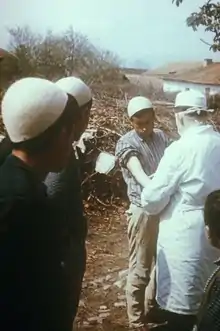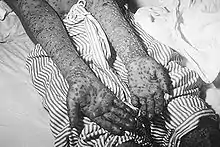1972 Yugoslav smallpox outbreak
The 1972 Yugoslav smallpox outbreak was the largest outbreak of smallpox in Europe after the Second World War.[1] It was centered in SAP Kosovo and Belgrade, a province of and the capital city respectively of Yugoslavia. A Kosovar Albanian Muslim pilgrim had contracted the smallpox virus in the Middle East. Upon returning to his home in Kosovo, he started the epidemic in which 175 people were infected, killing 35. The epidemic was efficiently contained by enforced quarantine and mass vaccination. The 1982 film Variola Vera is based on the event.[2]
| 1972 Yugoslav smallbox outbreak | |
|---|---|
 Field physicians checking an immunization reaction in a man during a smallpox epidemic, Kosovo, 1972 | |
| Disease | Smallpox |
| Virus strain | Variola |
| Location | SAP Kosovo and Belgrade, SR Serbia, SFR Yugoslavia |
| Index case | A Muslim pilgrim from SAP Kosovo |
| Dates | 16 February - 11 April 1972[1] |
| Confirmed cases | 175[1] |
Deaths | 35[1] |
Background
By 1972 the disease was considered to be eradicated in Europe. The population of Yugoslavia had been regularly vaccinated for 50 years, and the last case was reported in 1930. This was the major cause of the initial slow reaction by doctors, who did not promptly recognize the disease.[3]
In October 1970, an Afghan family went on pilgrimage from Afghanistan, where smallpox was endemic, to Mashhad in Iran, triggering an epidemic of smallpox in Iran that would last until September 1972. By late 1971, smallpox-infected pilgrims had carried smallpox from Iran into Syria and Iraq.[4]
Outbreak

In early 1972, a 38-year-old Kosovo Albanian Muslim clergyman named Ibrahim Hoti, from Damnjane near Đakovica, Kosovo, undertook the Hajj.[5] He visited holy sites in Iraq, where cases of smallpox were known. He returned home on February 15.[6] The following morning he suffered aches and was tired. After feeling feverish for a couple of days and developing a rash, he recovered,[7] likely because he had been vaccinated two months earlier.[8]
On March 3, Latif Mumdžić, a thirty-year-old teacher, who had just arrived in Đakovica to attend school, fell ill. He had no known direct contact with Hoti. He may have been infected by one of the clergyman's friends or relatives who visited during his illness, or simply by passing the clergyman in the street. When Mumdžić visited the local medical center two days later, doctors attempted to treat his fever with penicillin (smallpox is a virus, so this was ineffective). His condition did not improve, and after a couple of days, his brother took him to the hospital in Čačak, 150 km to the north in Serbia. The doctors there could not help him, so he was transferred by ambulance to the central hospital in Belgrade. On March 9, Mumdžić was shown to medical students and staff as a case of an atypical reaction to penicillin, which was a plausible explanation for his condition. On the following day, Mumdžić suffered massive internal bleeding and, despite efforts to save his life, died that evening. The cause of death was listed as "reaction to penicillin". In fact, he had contracted black pox, a highly contagious form of smallpox. Before his death, Mumdžić directly infected 38 people (including nine doctors and nurses), eight of whom died.[9] A few days after Mumdžić's death, 140 smallpox cases erupted across Kosovo province.[10]
Reaction
The government's reaction was swift. Martial law was declared on March 16. Measures included cordons sanitaires of villages and neighborhoods, roadblocks, a prohibition of public assembly, closure of borders and prohibition of all non-essential travel. Hotels were requisitioned for quarantines in which 10,000 people who may have been in contact with the virus were held under guard by the Yugoslav People's Army.[11]
Mumdžić's brother developed a smallpox rash on March 20, resulting in medical authorities realizing that Mumdžić had died of smallpox. The authorities undertook massive revaccination of the population, helped by the World Health Organization (WHO), "almost the entire Yugoslavian population of 18 million people was vaccinated". Leading experts on smallpox were flown in to help, including Donald Henderson and Don Francis.[12]
By mid-May, the outbreak was contained and the country returned to normal life. During the epidemic, 175 people contracted smallpox and 35 died.[13]
Legacy
The Yugoslav government received international praise for the successful containment of the epidemic, which was one of the finest hours for Donald Henderson and WHO, as well as one of the crucial steps in the eradication of smallpox.[12]
In 1982, Serbian director Goran Marković made the film Variola Vera about a hospital under quarantine during the epidemic.
References
- Ilic, Irena; Ilic, Milena (11 April 2022). "Historical review: Towards the 50th anniversary of the last major smallpox outbreak (Yugoslavia, 1972)". Travel Medicine and Infectious Disease. 48: 102327. doi:10.1016/j.tmaid.2022.102327. ISSN 1873-0442. PMID 35421599.
- Markovic, Goran (1982-07-09), Variola Vera, Rade Serbedzija, Erland Josephson, Dusica Zegarac, retrieved 2017-12-18
- Ferhadbegović, Sabina. "Cultures of History Forum : Past and Present Health Crises: How Yugoslavia Managed the Smallpox Epidemic of 1972". www.cultures-of-history.uni-jena.de. Retrieved 2021-07-06.
- "SMALLPOX SURVEILLANCE — Worldwide". Morbidity and Mortality. 21 (16): 137–139. 1972. ISSN 0091-0031.
- MATIC, Katarina SUBASIC and Jovan. "Memories Of Smallpox Outbreak Stir Nostalgia For Tito's Time". www.barrons.com. Retrieved 2021-07-06.
- "Smallpox in Yugoslavia" (PDF). The Climate Change and Public Health Law Site. 1972-09-22. Retrieved 2022-09-01.
- Bliss, Dominic (2020-04-16). "What will be the psychological legacy of quarantine? History may have answers". National Geographic. Retrieved 2022-09-01.
- Billauer, Barbara P. (2016). "Weapons of Mass Hysteria (WMH), Faulty Bio-Threat Predictions and its Impact on National (In)Security". Health Matrix: The Journal of Law-Medicine. doi:10.2139/ssrn.2749658. ISSN 1556-5068.
- "BBC - History - British History in depth: Smallpox: Eradicating the Scourge". www.bbc.co.uk. Retrieved 2021-07-06.
- Litvinjenko, S.; Arsic, B.; Borjanovic, S. (1972-11-24). "Epidemiological Aspects of Smallpox in Yugoslavia in 1972" (PDF). World Health Organization. Retrieved 2022-09-01.
- "Football Lockdowns: Smallpox outbreak in 1972". Football Makes History. 2020-04-29. Retrieved 2021-07-06.
- Herskovitz, Jon (2016-08-22). "D.A. Henderson, who led effort to eradicate smallpox, dies at 87". Reuters. Retrieved 2021-07-06.
- "Director of hit Yugoslav film about smallpox epidemic gets COVID jab". Reuters. 2021-01-26. Retrieved 2021-07-06.
Sources
- Flight, Colette (2002). Smallpox: Eradicating the Scourge hosted by BBC History. Verified availability 2005-03-12.
- Zwerdling, Daniel (October 23, 2001). Bioterrorism: Civil Liberties Under Quarantine. American Radio Works. Verified availability 2005-03-12.
External links
- Variola vera. Internet Movie Database entry for a film based on the 1972 smallpox outbreak in Yugoslavia. Verified availability 2005-03-12.
- Smallpox 2002: Silent Weapon hosted by Drama. Drama-documentary about a hypothetical bioterrorism attack involving smallpox. Verified availability 2005-03-12.
- Litvinkenko, S.; Arsic, B.; Borjanovic, S. (1973). Epidemiologic Aspectsof Smallpox in Yugoslavia in 1972 (PDF). WHO.
- Smallpox in Yugoslavia (PDF). CDC. 1972.